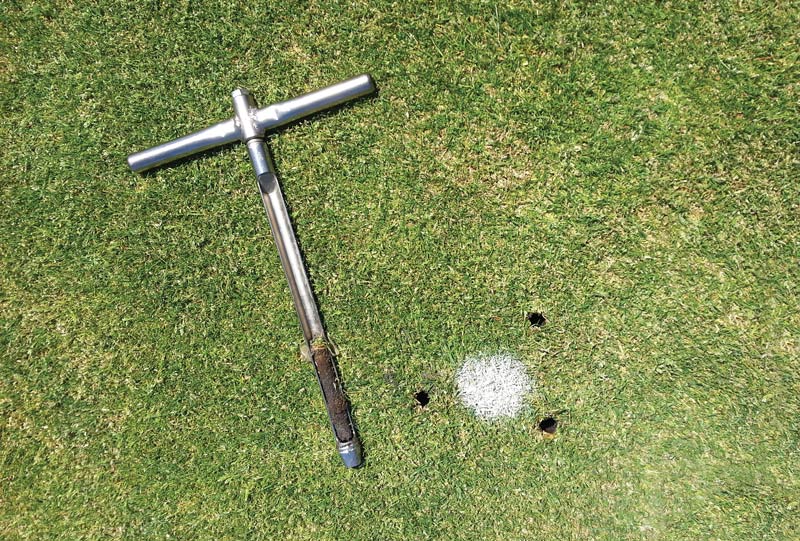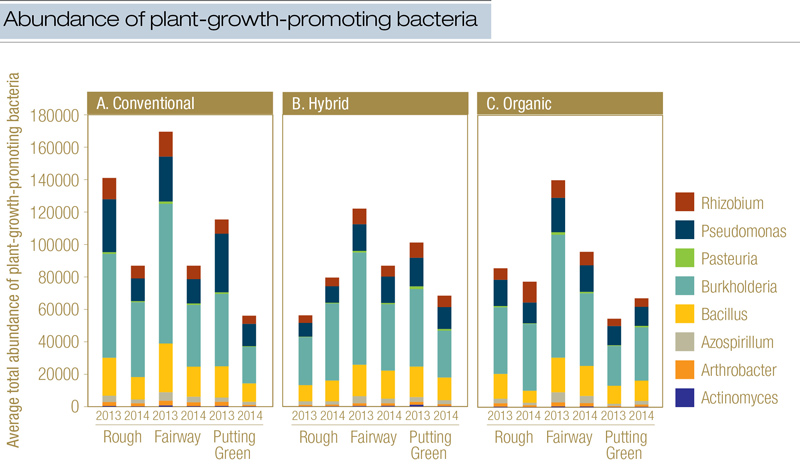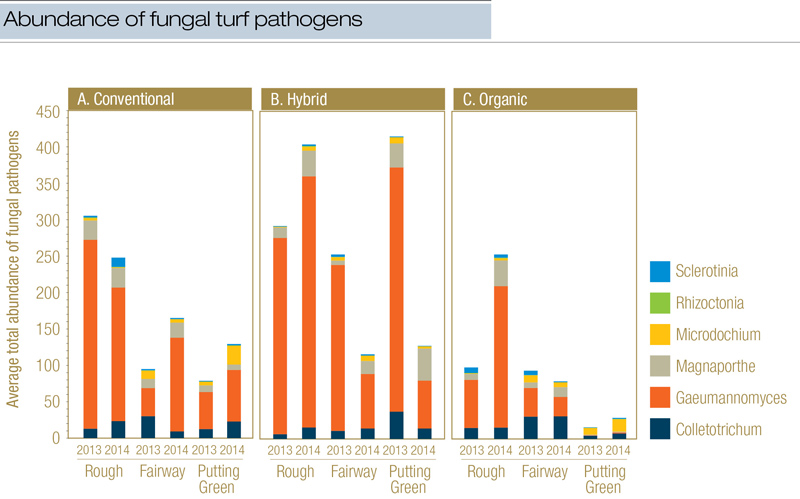
Figure 1. Soil samples were collected using a 1-inch-diameter (2.5-centimeter-diameter) soil corer at a depth of 4 inches (10 centimeters). Photo by Elisha Allan-Perkins
Editor’s note: This research was funded in part by the United States Golf Association.
Microbes, specifically bacteria and fungi, are present in all ecosystems, including the thatch and soil beneath golf courses. These microbial communities provide benefits to the turfgrass, such as biocontrol, promoting plant growth, degrading the thatch layer, detoxifying chemicals such as fungicides, and increasing plant tolerance to stresses, diseases and pests.
There is interest in using biological products that incorporate some of these microbes to mitigate or replace the need for chemical inputs, but these formulations often have inconsistent results (10). An alternative is to use practices that encourage beneficial microbes or increase the diversity of organisms to create a community that can better withstand stress from the environment (heat, drought, cold), pests or diseases.
Organic and low-input practices are believed to benefit the microbial community by increasing the biodiversity of microorganisms and the number of microbes involved in biocontrol and plant growth promotion. However, little is known about how management affects microbes on golf courses.
The aim of this study was to better understand the bacterial and fungal composition of the turfgrass soil community under different management intensities, represented by roughs (least intensely managed), fairways and putting greens (most intensely managed). We included an organic golf course and a low-input (referred to as a “hybrid”) course to compare with a conventional course, to look at the effects of management type. Because there is only one truly organic course in North America, we were not able to replicate all three management types for comparisons. We used established golf courses instead of research plots because we wanted to look at the cumulative effects of management inputs long term (specifically, after at least 10 years of management).
This is the first study to use metagenomic sequencing to characterize both bacteria and fungi from turfgrass soil in different management areas. This technology determines DNA sequences of individual organisms in an environmental sample, which are then compared with databases of DNA sequences from identified organisms in order to reveal the identity of the individuals in the environmental sample. Compared with previously used techniques, this method can provide a more detailed characterization of the bacteria and fungi on golf courses.
Methods
We sampled soil from roughs, fairways and putting greens of three holes per golf course in May of 2013 and 2014 (Figure 1, above). All three golf courses were located within 6 miles (10 kilometers) of each other in Massachusetts. The courses had similar grass species and management practices, with the exception of rolling and only organic products being used on the organic course, and reduced synthetic pesticide applications and the addition of a biocontrol bacteria in the irrigation lines of the fairways on the hybrid course. Another important difference was that the organic course had USGA sand-based putting greens, whereas the other two courses had push-up greens.
Soil samples were brought back to the laboratory for DNA extraction and soil analyses (pH, phosphorous, potassium, percent organic matter and soil texture). The extracted DNA was used for quantitative PCR (qPCR) and metagenomic sequencing to determine the bacterial and fungal compositions. Abundances of bacterial and fungal pathogens and microbes involved in plant growth promotion and biocontrol were calculated. Because bacterial and fungal species assignments are based on DNA sequence similarity, we reported on the genus of each organism instead of the species in order to be conservative in our estimates of diversity. The computer program PICRUSt (Phylogenetic Investigation of Communities by Reconstruction of Unobserved States) (4) was used to predict ecosystem functions — such as nitrogen fixation and chemical degradation — of the different bacterial species.
Results
Abundance and diversity with low-input management
Overall, we did see significant differences among microbial communities under different management strategies. Abundance and diversity of bacteria were similar among all management areas and golf courses, suggesting they are minimally affected by management practices. Fungal abundance and diversity were lowest on putting greens on all three golf courses, regardless of whether organic or synthetic products were used. This difference could occur because putting greens receive more fungicide applications than the other management areas. The fungicide applications may offset any benefits from higher nitrogen fertilization — which can increase fungal abundance — on putting greens (5).
Abundance and diversity with soil characteristics
Past research has shown pH, soil texture and nitrogen strongly drive bacterial and fungal communities. We wanted to test whether soil texture and nutrients were influencing differences in microbial communities on the golf course, regardless of different chemical inputs and intensities. However, we did not see any strong correlations with soil type and nutrients and bacterial or fungal abundance or species. We may not have measured an important environmental or soil property that was influencing the microbial populations, or the effect of management inputs may have been greater than the effect of soil type or nutrient.
Bacteria

Figure 2. Average relative abundance of plant-growth-promoting bacteria among the three management areas (rough, fairway and putting green) on (A) conventional, (B) hybrid and (C) organic courses.
Understanding turf soil microbes may allow turf managers to optimize fertilization based on the bacteria involved in the nitrogen cycle. Although we saw differences in the bacteria on the three golf courses and management areas, we did not see any trends that would suggest management areas or inputs affect nitrogen-cycling bacteria. Increasing populations of bacteria and fungi that promote plant growth may also help reduce fertility inputs, suppress weeds and potentially reduce disease. The abundance of bacteria with putative plant-growth-promotion activity varied among management areas on all three courses, but there was no trend suggesting management intensity was affecting overall populations (Figure 2).
Turfgrass bacteria have been shown to detoxify xenobiotic chemicals, such as pesticides (6, 7). We expected to find higher numbers of bacteria that could metabolize these compounds on the putting greens, as they receive more chemical inputs, but we found no significant differences among xenobiotic detoxifiers on the three courses.
Fungi
We found greater abundances of mycorrhizal fungi — which increase growth in many perennial turf species (2) — on the putting greens of the organic and conventional courses. In contrast with earlier studies, work published in 2005 found higher numbers of these organisms on putting greens (2), and the researchers speculated that the mycorrhizal fungi had developed resistance to fungicides, or that fungicides had never reached them in the soil. This could be true for our study, where the additional fungicides did not affect the mycorrhizae. Alternatively, the increased nitrogen applications on the putting greens could have led to greater populations of mycorrhizal fungi on the greens than on the fairways and roughs (3).
Disease incidence

Figure 3. Average relative abundance of fungal turf pathogens among the three management areas (rough, fairway and putting green) on (A) conventional, (B) hybrid and (C) organic courses.
Field research in Europe showed that lower-input agricultural systems increased disease suppressiveness (9). We expected to find fewer pathogenic bacteria and fungi on the roughs and fairways. Neither of the two turf bacterial pathogens, Acidovorax species or Xanthomonas species, were detected on the three courses. However, the abundances of fungal pathogens (Figure 3) were not lower on the roughs or fairways of any of the three courses, except for the genus Gaeumannomyces, which contains the causal agent of take-all patch. Other researchers found that the effect of fungicides on fungi is complex and often species-specific (8). Therefore, reducing golf course inputs may not decrease disease pressure of all pathogens.
Although we cannot directly compare golf courses because of incomplete replications, it is interesting to note that the organic course had fewer pathogens than the conventional and hybrid golf courses, supporting the idea that lower-input systems may have more disease suppressiveness. Future research studies could test this using replicate plots with identical management practices, grass species and soil type. Additionally, measuring the incidence of disease as well as the presence of the pathogens would be important to understanding whether and how disease suppressiveness was occurring.
Biocontrol organisms
Research has suggested that low-input management may reduce disease incidence because it causes an increase in biocontrol organisms. Bacillus species were actively applied to the fairways and putting greens of the organic course for biological control and were found in highest abundance on the organic fairways, suggesting they may have greater survival in this lower-input area.
After Pseudomonas aureofaciens was applied to the fairways of the hybrid course, Pseudomonas species were found in statistically similar abundance on the fairways and the putting greens, but in low abundance on the roughs. Why wasn’t the abundance of Pseudomonas species higher on fairways than on putting greens? It may be that the applied bacteria did not colonize the fairways, or that the putting greens had high populations of naturally occurring Pseudomonas species. The latter would be interesting to study to determine whether the increased management inputs on greens benefit Pseudomonas or simply do not affect it.

Figure 4. Average relative abundance of fungi with potential biocontrol abilities among the three management areas (rough, fairway and putting green) on (A) conventional, (B) hybrid and (C) organic courses.
For fungi, 25 genera with potential biocontrol activity were identified, but no overall trends suggested that the lower-input areas had more fungal biocontrol organisms than the putting greens (Figure 4). Two possible explanations for this result are that 1) we were not able to characterize all biocontrol organisms, or 2) the majority of biocontrol organisms and pathogens are found within the thatch, not the soil. As-yet-unidentified bacteria and fungi could be playing a role in biocontrol that could be affected by management practices. In this study, we characterized microbes from the soil, but potentially most of the pathogens and biocontrol microbes may be living in the thatch layer, which has a higher nutrient content than the soil. As described in an October 2018 article on GCMOnline.com, the causal agent of dollar spot disease (Clarireedia species) was greater in the thatch than in the soil on these same three golf courses (1). Therefore, future studies on the microbial communities of golf courses should focus on the thatch as well as the underlying soil.
Conclusions
Our study provided an initial characterization of the bacteria and fungi present on the roughs, fairways and putting greens of cool-season turfgrass golf courses. We found a diverse microbial community containing organisms with many different ecosystem functions. Our results show that management inputs have less of an impact on the abundance and diversity of bacteria than on fungal abundance and diversity, which are reduced on putting greens regardless of whether organic or synthetic products are used. Overall, the management areas did not show differences in nitrogen cycling, xenobiotic degradation, biocontrol or pathogenic microbes. However, we did see fewer pathogens on the organic course, which should be investigated further in a replicated study. Future research on microbial communities of turfgrass should include the thatch layer as well as the soil to get a more complete picture of how these organisms change with management strategies.
The bacteria and fungi on golf courses strongly influence turf health, and increasing our understanding of these organisms may hold the key to improving existing management strategies and creating new ones to increase turf health and potentially minimize inputs.
Funding
This research was partially funded by the United States Golf Association, the New England Regional Turfgrass Foundation, and the University of Massachusetts Plant Biology Gilgut Fellowship and University Fellowship. This material is based on work supported by the U.S. Department of Agriculture, National Institute of Food and Agriculture, the Massachusetts Agricultural Experiment Station, and the Stockbridge School of Agriculture at the University of Massachusetts Amherst, under project number MAS00436. The contents are solely the responsibility of the authors and do not necessarily represent the official views of the USDA or NIFA.
Acknowledgments
This research was previously published as “Soil microbial communities on roughs, fairways, and putting greens of cool-season golf courses” by Elisha Allan-Perkins, Daniel K. Manter and Geunhwa Jung in Crop Science 59:1753-1767 (2019). doi:10.2135/cropsci2018.04.0220
The research says ...
- In this study, a diverse microbial community containing organisms with many different ecosystem functions thrived on the roughs, fairways and putting greens of three cool-season turfgrass golf courses.
- Abundance and diversity of bacteria were similar among all management areas and among the three golf courses. Thus, bacteria may be minimally affected by management practices.
- The organic golf course had fewer pathogens than the conventional and hybrid golf courses, supporting the idea that lower-input systems may have more disease suppressiveness.
Literature cited
- Allan-Perkins, E., D.K. Manter and G. Jung. 2018. Abundance of bacteria, fungi, and Sclerotinia homoeocarpa in the thatch and soil of golf courses. Phytobiomes 2:71-81. doi:10.1094/PBIOMES-09-17-0036-R
- Bary, F., A.C. Gange, M. Crane and K.J. Hagley. 2005. Fungicide levels and arbuscular mycorrhizal fungi in golf putting greens. Journal of Applied Ecology 42:171-180. doi:10.1111/j.1365-2664.2004.00989.x
- Egerton-Warburton, L.M., and E.B. Allen. 2000. Shifts in arbuscular mycorrhizal communities along an anthropogenic nitrogen deposition gradient. Ecological Applications 10:484-496. doi:10.1890/1051-0761(2000)010[0484:SIAMCA]2.0.CO;2
- Langille, M.G.I., J. Zaneveld, J.G. Caporaso, D. McDonald, D. Knights, J.A. Reyes et al. 2013. Predictive functional profiling of microbial communities using 16S rRNA marker gene sequences. Nature Biotechnology 31:814-821. doi:10.1038/nbt.2676
- Mancino, C.F., M. Barakat and A. Maricic. 1993. Soil and thatch microbial populations in an 80% sand: 20% peat creeping bentgrass putting green. HortScience 28:189-191. doi:10.21273/HORTSCI.28.3.189
- Shi, W., D. Bowman and T. Rufty. 2007. Soil microbial community composition and function in turfgrass ecosystems. Bioremediation, Biodiversity and Bioavailability 1:72-77.
- Sigler, W.V., and R.F. Turco. 2002. The impact of chlorothalonil application on soil bacterial and fungal populations as assessed by denaturing gradient gel electrophoresis. Applied Soil Ecology 21:107-118. doi:10.1016/S0929-1393(02)00088-4
- Smiley, R.W., and M.M. Craven. 1979. Microflora of turfgrass treated with fungicides. Soil Biology and Biochemistry 11:349-353. doi:10.1016/0038-0717(79)90047-6
- Tamm, L., B. Thürig, C. Bruns, J.G. Fuchs, U. Köpke, M. Laustela et al. 2010. Soil type, management history, and soil amendments influence the development of soil-borne (Rhizoctonia solani, Pythium ultimum) and air-borne (Phytophthora infestans, Hyaloperonospora parasitica) diseases. European Journal of Plant Pathology 127:465-481. doi:10.1007/s10658-010-9612-2
- Vincelli, P., B. Clarke and G. Munshaw. 2017. Chemical control of turfgrass diseases 2017. University of Kentucky Cooperative Extension. (http://www2.ca.uky.edu/agcomm/pubs/ppa/ppa1/ppa1.pdf) Accessed April 11, 2017.
Elisha Allan-Perkins received her Ph.D. from the University of Massachusetts Amherst in plant biology, studying microbial communities of cool-season turfgrass on golf courses and athletic fields.